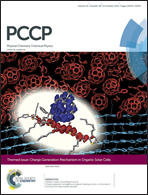The effects of counterion composition on the rheological and conductive properties of mono- and diphosphonium ionic liquids†
Abstract
A series of monocationic and dicationic phosphonium ionic liquids was prepared and their thermal, rheological, and conductive properties were characterized. These phosphonium ionic liquids were paired with seven monoanionic counterions (chloride, hexafluorophosphate, hexafluoroantimonate, octanoate, perfluorooctanoate, dodecyl sulfate, dioctyl sulfosuccinate, and bis(trifluoromethane)sulfonimide) in order to examine the effects of the counterion size and chemical structure on bulk properties of the phosphonium ionic liquids. The length of the three alkyl chains surrounding the phosphorus atom was also varied from butyl, hexyl to octyl on the cation. All of the samples exhibited initial decomposition temperatures above 150 °C. The octanoate and its fluorinated analog possessed the lowest decomposition temperature and the dicationic hexyl sample bis(trifluoromethane)sulfonimide possessed the highest (>370 °C). The dicationic butyl and hexyl chloride samples displayed similar G′, G″ and viscosity curves, whereas the dicationic octyl chloride sample exhibited significantly lower values. The frequency sweeps of the monocationic phosphonium ionic liquids were all similar and showed minimal side chain dependence. The monocationic phosphonium ionic liquids have higher conductivity than their dicationic analogs at all measured temperatures.


 Please wait while we load your content...
Please wait while we load your content...